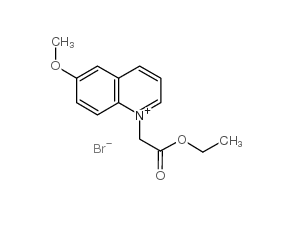
MQAE
CAS No. 162558-52-3
MQAE( MQAE )
Catalog No. M18096 CAS No. 162558-52-3
MQAE, a fluorescent chloride ion indicator, is more sensitive and selective than 36Cl and microelectrode-based methods for chloride measurement in cells.
Purity : >98% (HPLC)
 COA
COA
 Datasheet
Datasheet
 HNMR
HNMR
 HPLC
HPLC
 MSDS
MSDS
 Handing Instructions
Handing Instructions
| Size | Price / USD | Stock | Quantity |
| 25MG | 32 | In Stock |


|
| 50MG | 46 | In Stock |


|
| 100MG | 73 | In Stock |


|
| 200MG | 116 | In Stock |


|
| 500MG | Get Quote | In Stock |


|
| 1G | Get Quote | In Stock |


|
Biological Information
-
Product NameMQAE
-
NoteResearch use only, not for human use.
-
Brief DescriptionMQAE, a fluorescent chloride ion indicator, is more sensitive and selective than 36Cl and microelectrode-based methods for chloride measurement in cells.
-
DescriptionMQAE is a fluorescent indicator dye that can be used to measure intracellular and extracellular chloride concentrations (absorption/emission max: 350/460 nm).1 It detects the ion via diffusion-limited collisional quenching.
-
In Vitro——
-
In Vivo——
-
SynonymsMQAE
-
PathwayOthers
-
TargetOther Targets
-
RecptorOthers
-
Research AreaOthers-Field
-
Indication——
Chemical Information
-
CAS Number162558-52-3
-
Formula Weight326.19
-
Molecular FormulaC14H16BrNO3
-
Purity>98% (HPLC)
-
SolubilityDMSO : ≥ 35 mg/mL; 107.30 mM
-
SMILESCCOC(=O)C[n+]1cccc2c1ccc(c2)OC.[Br-]
-
Chemical Name1-(2-ethoxy-2-oxoethyl)-6-methoxy-quinolinium, monobromide
Shipping & Storage Information
-
Storage(-20℃)
-
ShippingWith Ice Pack
-
Stability≥ 2 years
Reference
1. Kovalchuk Y, et al. Two-photon chloride imaging using MQAE in vitro and in vivo. Cold Spring Harb Protoc. 2012 Jul 1;2012(7):778-85.
molnova catalog



related products
-
m-tolyl-acetate
m-Tolyl acetate is a intermediate of organic synthesis.
-
Dauricumine
Dauricumine is a chlorinated alkaloid that inhibits NF-κB ligand-induced differentiation of mouse bone marrow-derived macrophages into multinucleated osteoclasts.
-
Terpinolene
Terpinolene shows non-genotoxic and antioxidant features. Terpinolene is a potent antiproliferative agent for brain tumour cells and may have potential as an anticancer agent.



 Cart
Cart
 sales@molnova.com
sales@molnova.com


